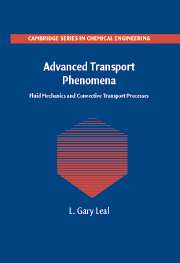Book contents
- Frontmatter
- Contents
- Preface
- Acknowledgments
- 1 A Preview
- 2 Basic Principles
- 3 Unidirectional and One-Dimensional Flow and Heat Transfer Problems
- 4 An Introduction to Asymptotic Approximations
- 5 The Thin-Gap Approximation – Lubrication Problems
- 6 The Thin-Gap Approximation – Films with a Free Surface
- 7 Creeping Flow – Two-Dimensional and Axisymmetric Problems
- 8 Creeping Flow – Three-Dimensional Problems
- 9 Convection Effects in Low-Reynolds-Number Flows
- 10 Laminar Boundary-Layer Theory
- 11 Heat and Mass Transfer at Large Reynolds Number
- 12 Hydrodynamic Stability
- Appendix A Governing Equations and Vector Operations in Cartesian, Cylindrical, and Spherical Coordinate Systems
- Appendix B Cartesian Component Notation
- Index
9 - Convection Effects in Low-Reynolds-Number Flows
Published online by Cambridge University Press: 05 June 2012
- Frontmatter
- Contents
- Preface
- Acknowledgments
- 1 A Preview
- 2 Basic Principles
- 3 Unidirectional and One-Dimensional Flow and Heat Transfer Problems
- 4 An Introduction to Asymptotic Approximations
- 5 The Thin-Gap Approximation – Lubrication Problems
- 6 The Thin-Gap Approximation – Films with a Free Surface
- 7 Creeping Flow – Two-Dimensional and Axisymmetric Problems
- 8 Creeping Flow – Three-Dimensional Problems
- 9 Convection Effects in Low-Reynolds-Number Flows
- 10 Laminar Boundary-Layer Theory
- 11 Heat and Mass Transfer at Large Reynolds Number
- 12 Hydrodynamic Stability
- Appendix A Governing Equations and Vector Operations in Cartesian, Cylindrical, and Spherical Coordinate Systems
- Appendix B Cartesian Component Notation
- Index
Summary
In the preceding chapters, we focused mainly on fluid dynamics problems, with only an occasional problem involving heat or mass transfer. In this chapter, we change our focus to problems of heat (or single-solute mass) transfer. Specifically, we address the problem of heat (or mass) transfer from a finite body to a surrounding fluid that is moving relative to the body. In this chapter, we concentrate on problems in which the fluid motion is viscous in nature, and thus is “known” (or can be calculated) from creeping-flow theory. Later, after we have considered flows at nonzero Reynolds number, we will also consider heat (or mass) transfer for this situation.
In all of the fluid mechanics problems that we have considered until now, the nonlinear inertia terms in the equations of motion were either identically zero or small compared with the viscous terms. We begin this chapter by considering the corresponding heat (or mass) transfer problem, in which the fluid motion is “slow” in a sense to be described shortly, so that convection effects are weak and the transport process is dominated by conduction. When convection terms in the thermal energy equation can be neglected altogether, the resulting pure conduction problem is mathematically and physically analogous to the creeping flows that we have been studying in the preceding two chapters. The transport of heat is purely “diffusive” in this limit, i.e., conduction, just as the transport of momentum (or vorticity) in a creeping flow is also “diffusive.”
- Type
- Chapter
- Information
- Advanced Transport PhenomenaFluid Mechanics and Convective Transport Processes, pp. 593 - 696Publisher: Cambridge University PressPrint publication year: 2007



